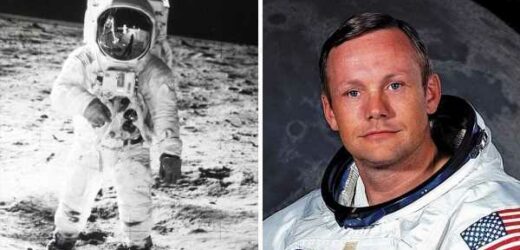Michael Collins reflects on Apollo 11 mission in 2019
We use your sign-up to provide content in ways you’ve consented to and to improve our understanding of you. This may include adverts from us and 3rd parties based on our understanding. You can unsubscribe at any time. More info
Today is the last day a series of shots of various NASA Moon missions are on sale at Christie’s auction house. The auction, ‘Moon Shots: Space photography 1950-1999′, is a specially curated online catalogue of iconic photos of the early rocket launches on humans’ first footsteps on the Lunar surface. Comprising 327 photographs it documents a “wide-ranging view of the Golden Age of space exploration” to collection spans the Fifties, with the launch of Atlas, to the late Nineties, and images also capturing the beauty and essence of Saturn’s rings, as well as an exciting string of other pieces of space history.
Among the most evocative photographs are stills of Neil Armstrong and Buzz Aldrin, the men who became the first humans in history to step foot on the moon in the first-ever untethered space flight.
The images are iconic and instantly recognisable, but over the years, as Armstrong’s name became synonymous with the Apollo 11 mission, so did the photographs become synonymous with him.
But, as Kiona N Smith, a science writer exploring the snaps in Forbes noted, this is far from the truth.
Revisiting the photographs in a 2019 report, she said: “Have you ever gone on a trip with friends, only to discover afterward that there’s only one picture of you from the whole trip, and it includes your posterior rather than your face?


“Apollo 11 astronaut Neil Armstrong could probably relate to that. He’s partially visible, or shows up as a reflection, in about four other photos.
“But this photo of him with his back to the camera, working on something attached to the outside of the lunar module, is the only full-body image of Armstrong on the surface of the Moon.”
For most of the time he spent on the Moon, Armstrong was in fact the one holding the camera, meaning that nearly every photo taken on that mission is of Aldrin.
Arriving at the Moon the pair had a long list of tasks to carry out but just a brief window in which to complete them.
JUST IN: Energy crisis: Europe is sitting on enough gas reserves to replace …

According to Ms Smith, the astronauts later commented that the thought of who was in the pictures had never crept into their minds.
The pair never managed to take a snap together either — quite understandably given that the third astronaut, Michael Collins, had to stay on the ship to ensure everything was ticking over
The only shot of the pair “together” is of Aldrin, staring down the lens behind his wide visor, with Armstrong visible in the reflection of his helmet in the distance alongside part of their craft at Tranquility Base.
After they completed their historic mission Aldrin took some photographs of Armstrong inside the lunar module.
DON’T MISS
NASA finds more than 1,000 unknown asteroids hiding in old Hubble pics [REPORT]
Finland sends defiant message to Russia after voting to join NATO [INSIGHT]
Sweden can deploy ‘more than 1,000’ fighter planes to help Ukraine [ANALYSIS]

![]()
The last time humans went to the Moon was for Apollo 17 in 1972, a 12-day mission which broke many records, including the longest spacewalk, the longest lunar landing and the largest lunar samples brought back to Earth.
It would take NASA another 47 years to announce a new and exciting Moon mission on what was the 50th anniversary of the Apollo moon landings in 2019.
Project Artemis, as it is called, has one monumental goal: to create a permanent human Moon base.
Estimated to eventually cost a staggering $93billion (£75billion) by 2025, NASA’s first milestone in the programme is the Artemis I mission, which is due to launch from Kennedy Space Centre in mid-2022.

This will comprise of a four-week return mission to the lunar surface, and will be the first integrated test flight of NASA’s Deep Space Exploration System, which includes the Orion spacecraft, Space Launch System (SLS) rocket, as well as the Exploration Ground Systems (EGS) at Kennedy Space Centre.
Unfortunately for those watching eagerly, there will be no actual Moon landing for Artemis I, but it will lay the foundations for future Artemis missions to build on.
The spacecraft itself has a launch window of two weeks every month when the Moon is in the correct position relative to the Earth, and once the mission has made its way off the launch pad at the Centre, its objectives will be long and complex.
Artemis I will deploy what are known as CubeSats, tiny little blocks of technology that serve for observational purposes, in this context to watch the Moon and find out more about it.

The Orion craft will travel thousands of kilometres beyond the Moon in a retrograde orbit, as well as carry out two extremely close flybys, gliding around 100kilometres over the lunar surface.
Artemis II, meanwhile, will repeat the flight but with 11 astronauts on a ten-day mission that will in itself break a record by travelling further beyond the far side of the Moon than any manned mission has before.
But it is Artemis III that will be the most important of the missions: consisting of Orion and a crew of four, it will again travel to the Moon and again make history by carrying the first woman and the first person of colour to walk on its very surface.
Source: Read Full Article


